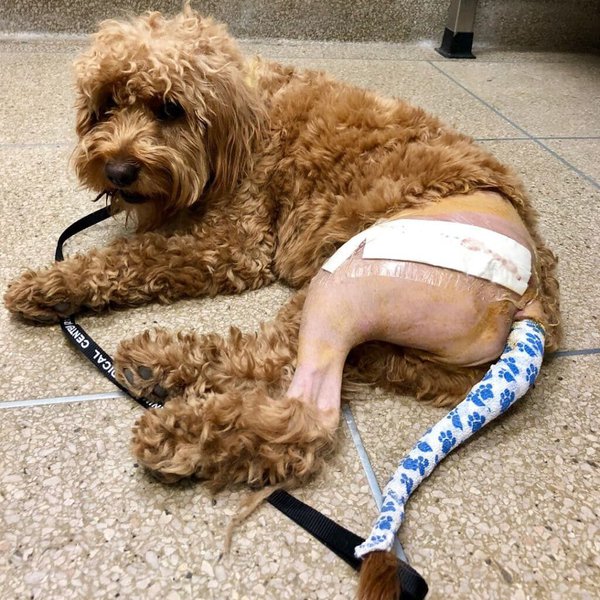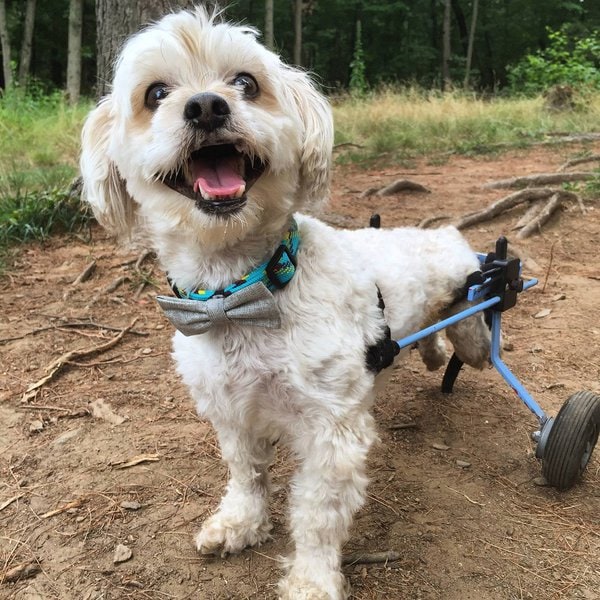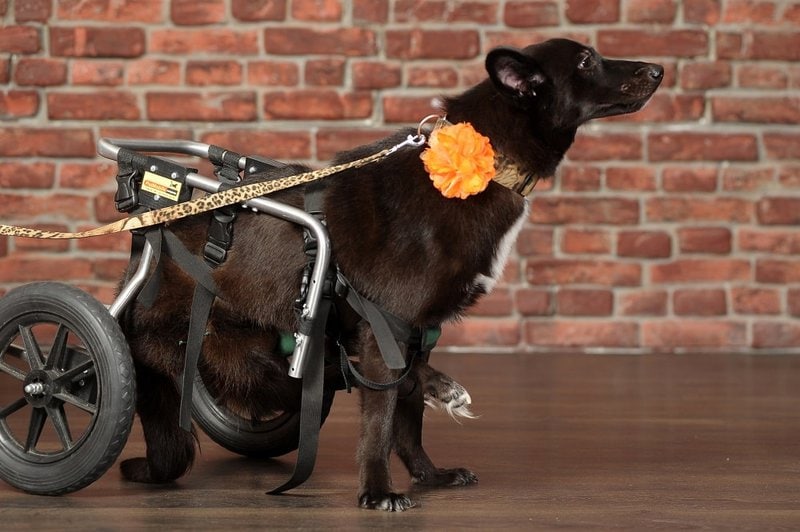One of the most commonly reported problems in dogs, both young and old, is back leg weakness. And there’s a lot to be said about how back leg weakness develops in dogs, as well as possible treatment methods. So then, what are the causes of dog back leg weakness?
Common causes of back leg weakness in dogs include medical conditions such as osteoarthritis, degenerative myelopathy, and canine hip dysplasia. In addition, older dogs are liable to experience back leg weakness, and poisoning can cause sudden paralysis of a pooch’s back legs.
It’s not all doom and gloom though, as most cases of weak back legs can be treated and managed. And tips on how to improve your pooch’s bone and muscle health for stronger back legs are contained in this article. However, before we go further, let’s have a look at some of the medical conditions that may cause a pooch’s back legs to suddenly give out, as well as symptoms typically exhibited by dogs suffering from these conditions.
What Causes A Dog’s Back Legs To Suddenly Give Out?
Common causes of a dog’s back legs suddenly giving out include medical conditions such as degenerative myelopathy, hip dysplasia, Intervertebral disc disease, and arthritis, just to mention a few.
Degenerative Myelopathy
Canine degenerative myelopathy is a disease of the spinal cord that causes gradual paralysis, and eventual collapse of the affected pooch’s hind legs.
The exact cause of Degenerative Myelopathy is yet to be determined, but it is suspected that this medical condition occurs mostly due to a genetic mutation.
That said, common symptoms of degenerative myelopathy in dogs include:
- Difficulty getting up from a lying position
- Falling over easily when pushed from the side
- Swaying of the hindquarters when the pooch is in a stationary position
- Loss of coordination in the pooch’s hind legs
- Toe dragging
In severe cases, degenerative myelopathy may spread to a dog’s forelegs, thereby crippling them.
It is also worth noting that degenerative myelopathy is a progressive disease, and with a cure yet to be found, pooches suffering from this condition will experience, in addition to the loss of their hind legs, a loss of bowel and bladder control.
Hip Dysplasia
Hip dysplasia is a medical condition that is characterized by the abnormal formation of the hip socket joint, and this is another disease that may be responsible for a dog’s back legs suddenly giving out.
Large-sized dogs are predisposed to suffering from hip dysplasia, but this condition is mainly caused by genetics and aggravated by factors such as obesity, inappropriate diet, excessive growth rate, and the intensity of physical activities.
Dogs suffering from hip dysplasia typically exhibit:
- Weakness in the hind legs
- Reluctance to stand from a sitting or lying position
- Limping movements
- Loss of muscle mass in the hind legs
- An increase in shoulder muscle mass to compensate for loss of muscle in the back legs

Intervertebral Disc Disease
The Intervertebral (or Degenerative) Disc Disease (IVDD) in dogs refers to a medical condition that causes the spontaneous rupture of the cushioning discs that contribute to protecting the pooch’s spinal cords. And one of the possible effects of IVDD on a dog is the weakness of the back leg.
The list of causes of IVDD in dogs includes injury from physical trauma and aging. But it is also believed that certain dog breeds such as the German Shepherd, Cocker Spaniel, and Dachshund are genetically predisposed to this disease.
Symptoms of IVDD in dogs are similar to those of other bone-related issues and they include:
- Unwillingness to move
- Reduced activity levels
- Loss of bladder and bowel control
- Awkward walking steps, and
- Lameness of the hind legs
Arthritis
Dogs, just like humans, are prone to arthritis, a disease that causes inflammation and collapse of bone joints around the pooch’s body, intense pain, and back leg weakness.
Elderly dogs are particularly at risk of developing arthritis, but young dogs with abnormal body conformation, abnormal joint history, excessive weight, and a history of injuries are also likely to develop this condition.
Pooches suffering from osteoarthritis typically exhibit symptoms such as:
- Lameness in the legs
- Movement difficulties
- Reluctance to be physically examined
- Swelling at joints
- Stiff movements
- Unwarranted aggression
Other Medical Causes Of Back Leg Weakness In Dogs
Apart from those explained above, the list of medical conditions that may also be responsible for the sudden collapse of a dog’s back legs include:
- Diabetes
- Cushing’s disease
- Wobbler syndrome
- Bone cancer
- Infections
What Causes A Dog To Suddenly Not Be Able To Walk?
Factors that may cause a dog to suddenly lose the ability to walk include old age, obesity, and poisoning.
Old Age
Generally, as a dog grows older, its back leg muscles weaken, and this usually culminates in the eventual collapse of the back legs, and an inability to walk.
Typically, dogs become less active as they age, thereby leading to a loss of important muscle mass and a subsequent reduction in mobility.

Obesity
The health hazards associated with leaving your pooch to become overweight are not to be overlooked, and one of these hazards includes loss of back leg function.
As a dog’s weight increases, its back legs gradually lose the ability to support the added weight, and one day, you’ll wake up to discover that the pooch can’t get up and walk.
Poisoning
Exposure to dangerous toxins from plants, insects, and chemicals can induce paralysis in a dog, and result in the pooch suddenly being unable to walk.
How Can I Help My Dog With Weak Back Legs?
You can help your dog with weak back legs by taking it to the vet for a medical check-up immediately after you have noticed the symptoms, and by making adjustments to your environment to make movement easier for the dog.
Treatment of weak back legs in dogs varies considerably, and a vet will have to carry out a comprehensive medical examination to diagnose the underlying cause of the back leg weakness, and subsequently prescribe appropriate treatment.
Some of the more common treatment methods for weak back legs in dogs include medications to address infections and inflammation, as well as surgery to treat advanced medical conditions such as cancer and vertebral fracture.
In addition to the use of medications to treat back leg weakness, dogs suffering from this condition must also get sufficient rest, and in this case, a confinement cage will come in handy.
For back leg weakness that leads to permanent disability, vets typically recommend the use of special harnesses, orthopedic braces, or walking devices to support the pooch’s hind legs and aid mobility.
Physical Therapy
Even as you administer medication to treat medical conditions responsible for your pooch’s back leg weakness, physical therapy can help the pooch to regain and strengthen lost muscle mass.
Hence, you may want to consider getting a physical therapist to put your pooch through the paces and speed up the recovery process.
Make Adjustments To Your Home Environment
Smooth floor surfaces can pose a problem for elderly dogs with weak back legs trying to move around. And to make movement easier for your pooch, you should look into acquiring materials and making adjustments to improve such a pooch’s traction.
Get rid of slick, smooth surfaces such as tiles by making rid of rugs, and you can also invest in toe grips or special doggie socks to aid your pooch’s grip.
In addition, if your home has stairs, you can incorporate ramps or special pet steps to assist the pooch to get up the stairs or even carrying the pooch up yourself.

How To Prevent Back Leg Weakness In Dogs?
While it may be considered difficult to prevent back leg weakness caused by medical issues and aging, there are steps you can take to reduce your pooch’s susceptibility to this condition.
Some of the ways by which you can protect your pooch from developing back leg weakness include:
Feeding An Appropriate Diet
When feeding your pooch, you should go for products that contain food ingredients known to promote healthy bone, joint, and muscle development.
Calcium is a very good source of nutrition for improving bone and back leg strength in dogs, and it can be readily found in food substances such as vegetables, yogurt, chicken, fish, and supplements.
In addition, feeding a meal rich in omega-3 fatty acids will go a long way in relieving the joint pain associated with arthritis.
Avoid Overfeeding Or Underfeeding Your Pooch
Dogs that eat too much are likely to become obese and develop weight issues. And to prevent this from happening, find and consistently feed your dog the right amount of food.
Similarly, by feeding your pooch with too little food, there is every chance that such a dog won’t get sufficient nutrients for muscle and bone development; Hence, it is also important that you avoid starving your pooch.
Regular Exercising
By regularly engaging your dog in quality exercises, you can prevent such a pooch from gaining unhealthy weight, strengthen leg muscles, and subsequently avoid issues with back leg weakness.
However, as earlier stated, excessive exercising can also aggravate certain medical conditions that cause back leg weakness in dogs; Hence, it is important that you strike a healthy balance when it comes to exercising your pooch.





